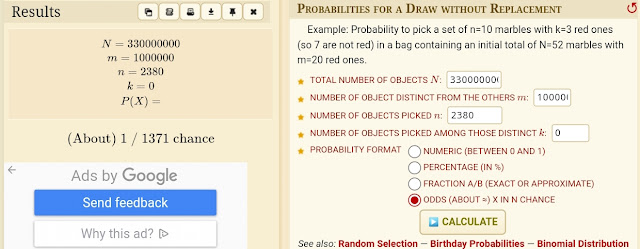Jabbed/dead on the same day?
A popular habit amongst certain ... people is to amplify reports where someone had a vaccine and died within a short period after. Of course, they take no care to check what the background rate might be given no correlation. Essentially, this is an 'overlap' problem: the likelihood of intersect between two sets m (today's vaccinees) and n (today's deaths) drawn independently from a population N. Since you only die once, or get vaccinated once on any given day, it is sampling without replacement.
Let's take the US.
- N is 330 million.
- m (set 1) is the number of vaccinations in a day, say 1 million.
- n (set 2) is the number of cardiovascular deaths a day, which is about 2380.
So what's the probability that at least 1 person in the 'vaccinated today' set will also be in the 'death today' set? The calculation itself is fiddly***, but I like this calculator. The example is picking marbles, but it is much the same thing. There are 330 million 'marbles' (N), and a million of them (m) are marked with a 'V'. You then pick 2380 (n) from 330 million as random cardiovascular victims. What is the chance that none of them is marked with a 'V' (k=0)? Turns out it's 1 in 1371 - on average, 1370 of every 1371 days has at least one case of a cardiovascular death in a vaccinee which is not due to the vaccination.
Now, that's just the days with at least one; we'd like to know the peak, as it is probabilistic and there will be a distribution. There may be a better way of doing this, but rather clunkily I just increment k on the calculator till I get to the lowest odds - the number of matches from such daily draws that would appear most frequently. With the above numbers, the peak is about 7, and coincidentally 1/7th of days will have that median 7 unfortunate victims. Other days will be higher or lower of course, but only 1/1371 will have none. More days will have 17 than have none.
We could of course reverse the timeline. Exactly the same probabilistic reasoning would apply if we chose the 24 hours before a vaccine appointment as our period of interest. Of course then we would not be tricked into ascribing a causal relationship: we are primed to see causality in temporal sequence. But just as many will die in the 24 hours before the appointment as in the 24 hours after.
If we allow for death within 2 days, the odds shoot up astronomically. m=2000000 and n=4760 over 2 days. You'd have to see 3686319852719 day pairs to find one with no randomly associated deaths at all. The median is now 28 random deaths per 2-day pair. Since vaccine skeptics will claim a vaccine death even 3 months later, it is clear that vast numbers would be expected simply by chance over such longer periods.
The association is not random of course, even if there is no causal link. Vaccinees are more likely to be older or have comorbidities predisposing them to cardiovascular issues. The above is therefore simply a baseline eliminating all confounders, and the reality may be higher. Note also that I have focused on just one group of causes: one of the more popular ones in Anti[justthis]vax World.
For these reasons, the single, associative cases that people trot out as evidence of vaccine harm are meaningless. At the very least you need to know the background probability of intersect, and a summary statistic to compare it against. You can't do this with single data points.
____________
*** - the formula, for anyone interested, from the calculator


Comments
Post a Comment